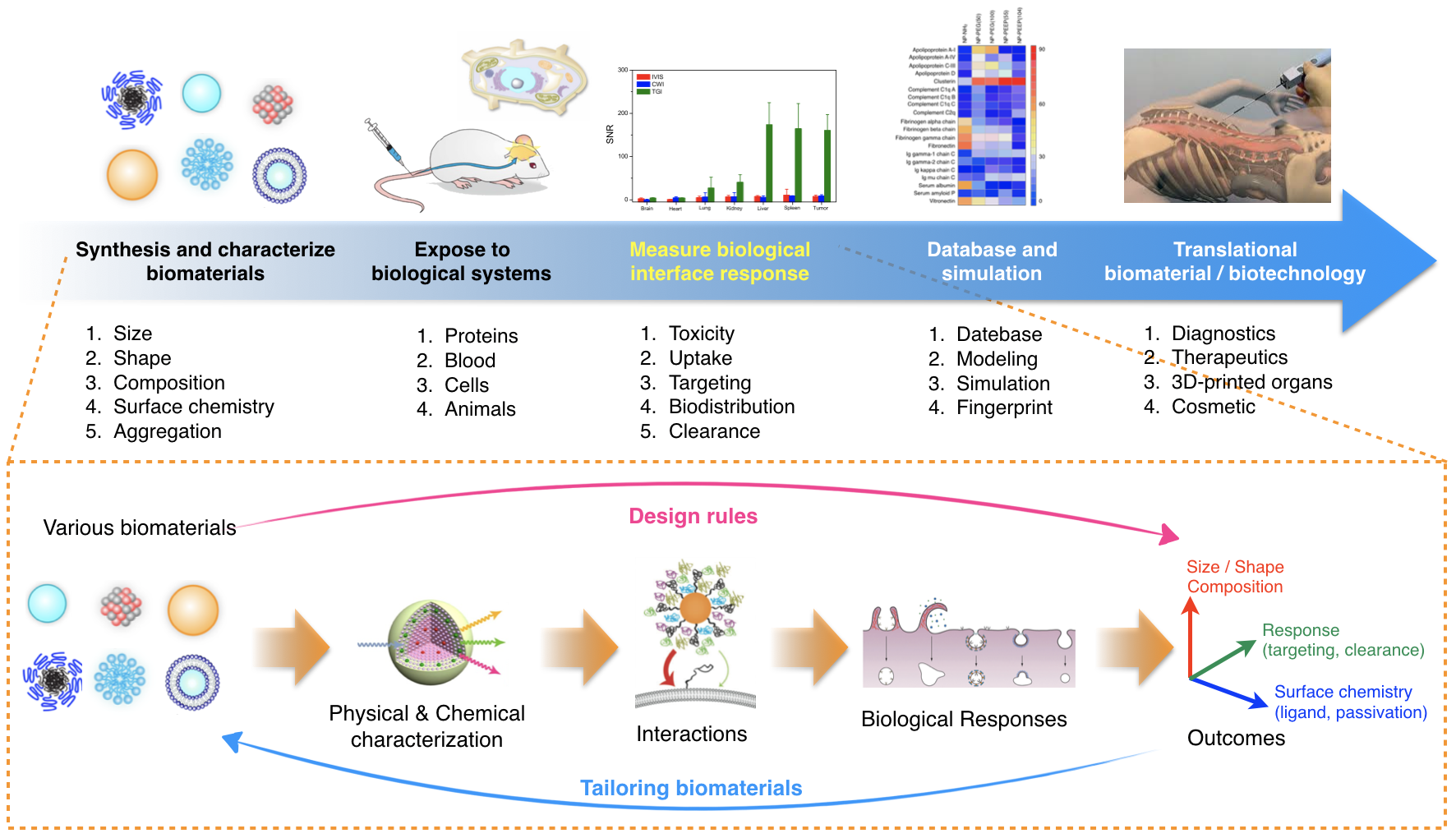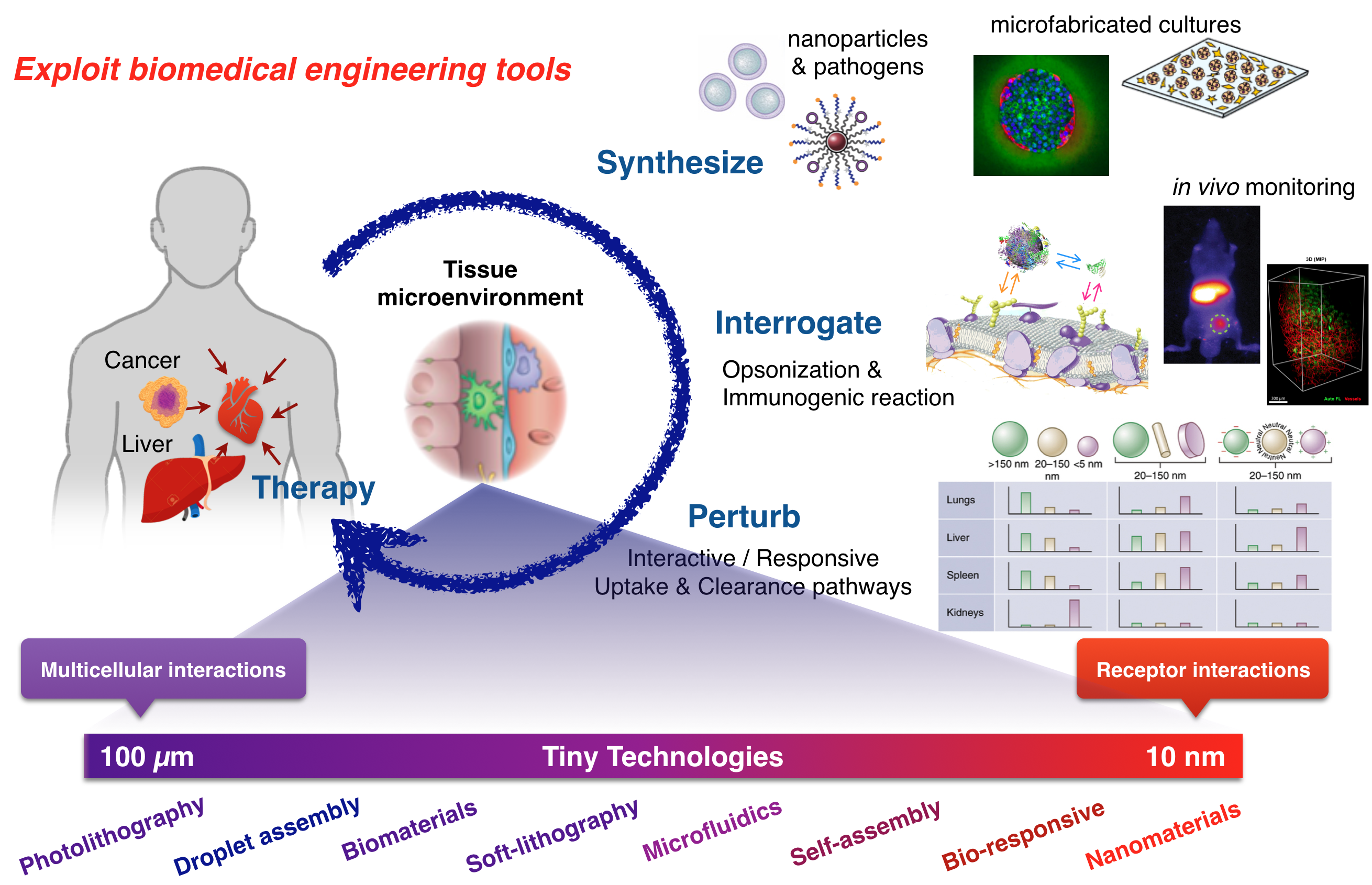Overview: Systems Nano-Bioengineering
Nanomaterials hold promising potentials as multifunctional biomedical platforms for diagnostics and therapeutics. However, limited understanding and connection between the physicochemical characteristics of the synthetic nanomaterials and the interactions with complex biological systems hamper clinical application of nanomaterials. Studying on the chemical and physiological properties of nanomaterials at the interface can provide rational design rule-how to optimally synthesize and chemically modify the materials-for developing clinically relevant nanomaterials. We’re interested in utilization of functional nanomaterials as translational biomedical platforms. In addition, understanding the principles governing the design of nanomaterials is essential for biological applications. In the lab, we will set a cutting-edge foundation of engineering sophisticated multi-scale biomedical systems for translational medicine. In order to achieve the goals, we emphasize fundamental understandings of how nano-structured biomaterials interact with biological systems, and investigate the thermodynamic and kinetic basis of physicochemical interactions between synthetic biomedical materials and complex biological systems, with a specific focus on the surface chemistry and interface engineering Along with the basic science studies utilizing the tools of cellular and molecular biology, we aim to make cellular and molecular therapies effective and practical approaches to treat diseases.

Advanced Biomaterials and Regenerative Medicine
The group is interested in developing novel nanomaterials and translational medicines to address critical biomedical challenges. We aim to leverage the power of state of the art chemistry and materials science to advance the diagnosis and therapy of diseases including cancer, infection, neurodegenerative, and inflammation using engineering tools, with a special focus on multiscale biomedical materials, surface chemistry, and molecular biology. The ultimate goal is to translate what we learned from complex biological systems to new engineering approaches aimed toward the development of novel biomedical materials used in the design of smarter and more effective diagnostics/therapeutics for clinical applications. Specifically, there are three complementary components in our research agenda:
– We aim to transform the way that researchers currently detect diseases through innovations in the design and development of nanomaterials-based diagnostic biosensors that could be used to detect a number of diseases with global implications, such as cancer, myocardial infarction, and pneumonia. These innovations in the platform design will involve accomplished work from my previous studies, and also development of completely new diagnostic/therapeutic biomedical nanomaterials that are multifunctional, dynamic, and capable of being triggered externally on demand for drug delivery and bioimaging. These biomedical materials provide several different types of information to cells in their environment, and thus mimic many functions of the native extracellular matrices found in tissues. This aspect of our study involves the design and syntheses of new biomedical nanomaterials, development of new processing approaches for existing biomaterials, and extensive physical and biological characterization of the resulting tissue engineering scaffolds.

(ii) Study of the interdependent interactions between synthetic biomedical materials and the complex biological systems, in particular, at material-cell and material-protein interface.
– We will emphasize a fundamental understanding of how synthetic nanomaterials interact with complex biological systems. The results will be then applied back to design and synthesize new biomaterials that provide desirable cues in a spatiotemporally regulated manner to regulate the gene expression of interacting cells. For example, the performance of nanoparticle drugs often depends on the sensitive interplay between the multiple functionalities of the nanoparticle and its response to the biological environment, which, in turn, can impact the transport, distribution, and drug release of the nanoparticles. The knowledge of how nanoparticle properties change with correspondence to the biological environment can aid in the design of nanoparticle drugs. Using this knowledge, we can then control the physical chemical properties, composition, and formulation process of the nanoparticles themselves.

(iii) Precise control of the physicochemical or physiological properties of nanomaterials to advance the design of synthetic scaffold structures for cell-instructive biomedical materials.
– Since cells are inherently sensitive to local microenvironment of chemistry and topography, the group will develop approaches to control cell behavior through nanoscale engineering of biomedical materials surfaces including polymers, peptides, ligands, and other topographies/chemistries. The biomedical nanomaterials will be used in a variety of tissue engineering, immunotherapy, and drug delivery to promote the regeneration or targeted destruction of tissues in the body. Far-reaching implications are emerging applications for regenerative medicine using stem cells, medical implants, and cell supporting scaffold that can be used as instructive environments for tissue regeneration or 3D-printed organs. We will provide techniques to better understanding and exploit the interfacial modulation, which is an extremely sophisticated yet complicated dynamic interaction. Since there are thousands of lipids, proteins, and carbohydrates located on or within the lipid bilayer that are arranged across multiple length scales, understanding and engineering the surface chemistry and interactions occurring at the interface between the cell surface and biomaterials is an enormous task for clinical applications. The group will also develop innovative methodologies to investigate the influence of the synthetic nanomaterials on biological behavior and to precisely control the physicochemical properties. The topographical cues and surface properties presented by underlying or surrounding material substrates need to be identified to determine how they instruct adjacent cells. This exploration can be expanded to emerging applications such as drug delivery, imaging, and medical implant as well as artificial tissues.

Biomaterials are widely tested in clinical applications to date, and the field has seen steady growth over several decades. It is highly multidisciplinary, as it merges medicine, biology, chemistry, materials science and engineering. While biomaterials were traditionally designed to be inert in a biological environment, new biomaterials capable of triggering specific biological responses at the cell-material interface have been reaching biomedical applications. We will be extending current stages of biomaterials and designing biomedical nanomaterials that are multifunctional, dynamic, and capable of being triggered externally on demand.
Tasks on elucidating the interactions of nanomaterials with biological systems are quite daunting, that needs to consider chemical composition, dimension, shape, surface chemistries, and overall complexity of physiological systems. However, these studies are indispensable. Although complete evaluation of the importance of each parameter in biological system can take several decades, such an endeavor will be beneficial to the field of nanomaterials and nanotechnology. These studies will provide important design parameters to engineer safe and efficient biomaterials and biomedical devices as tools for a variety of biochemical & medical applications. Fundamental studies on the interactions of synthetic nanomaterials with biological systems are important to the advancement of nanomaterials-based biomedical research and translational applications. In the lab, we will encompass molecular-to-systems level analysis, design, and synthesis of biomedical materials and devices for a range of applications in translational medicine. Most projects are highly interdisciplinary involving basic scientists, clinicians, and engineers, often with industry partners, to solve important problems in medicine and life science.